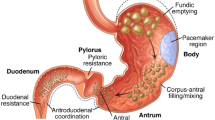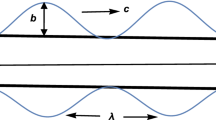Abstract
We used a finite element model to simulate flow through the intestine induced by peristalsis and segmentation. These models explored the effects of varying the rheological properties of digesta, incorporating a slip effect at the wall and the presence of an area of lumen distension adjacent to the area of vorticeal mixing that developed during peristalsis. Reynolds numbers were consistently low (<200) throughout all simulations indicating that local conditions were insufficient to bring about turbulence. When the viscosity of the material flowing through a simple tube model was increased, the area of the vortex orad (upstream) to the zone of peristaltic coaptation was relatively reduced, whilst that aborad (downstream) to the zone of peristalsis was increased. This effect was reduced when the material in the lumen had shear thinning properties. When a region of relative distension of the lumen that travelled aborad to the zone of peristalsis was incorporated into the model, the total area of vortex formation was reduced when material of either high or low Newtonian viscosity was in the lumen. However, these reductions were small compared with those obtained when slip at the intestine wall was incorporated into the model. Incorporation of slip resulted in a marked reduction of both orad and aborad vortices, an effect that persisted when the other effects were incorporated into the same model. The authors conclude that the translocation of nutrients from the intestinal lumen to the wall by action of short-lived vortices will be significantly reduced when the apparent viscosity of digesta is high and there is significant slip at the wall, even when digesta is a shear thinning, non-Newtonian fluid. Hence, the consumption of a diet that contains a high proportion of fibre or other insoluble residue will physically impair absorption by reducing vorticeal flow and promoting creep flow.













Similar content being viewed by others
References
Bryant MG, Bloom SR (1979) Distribution of the gut hormones in the primate intestinal tract. Gut 20:653–659
Christensen J (1993) Motility of the intestine. In: Sleisenger MH, Fordtran JS (eds) Gastrointestinal disease, vol 1, 5th edn. Saunders, Philadelphia, pp 822–837
COMSOL AB (2004) ALE models. In: FEMLAB Model Library. COMSOL AB, Stockholm, pp 165–180
Davenport HW (1989) Gastrointestinal physiology 1895–1975; motility. In: Wood JD (ed) Handbook of physiology, sect 6: the gastrointestinal system, vol 1 part 1. American Physical Society, Bethesda, pp 1–102
Dillard S, Krishnan S, Udaykumar HS (2007) Mechanics of flow and mixing at the antroduodenal junction. World J Gastroenterol 13:1365–1371
Dyer J, Salmon KSH, Zibrik L, Shirazi-Beechey SP (2005) Expression of sweet taste receptors of the T1R family in the intestinal tract and enteroendocrine cells. Biochem Soc Trans 33:302–305
France J, Thornley JHM, Siddons RC, Dhanoa MS (1993) On incorporating diffusion and viscosity concepts into compartmental models for analysing faecal marker excretion patterns in ruminants. B J Nut 70:369–378
French SJ, Reid NW (1994) Effect of guar gum on hunger and satiety after meals of differing fat content: relationship with gastric emptying. Am J Clin Nut 59:87–91
DeGennes PG (2002) On fluid wall slippage. Langmuir 18:3413–3414
Gregersen H (2003) Biomechanics of the gastrointestinal tract: new perspectives in motility research and diagnostics. Springer, New York
Gwynne RM, Thomas EA, Goh SM, Sjovall H, Bornstein JC (2004) Segmentation induced by intraluminal fatty acid in isolated guinea pig duodenum and jejunum. J Physiol 556:557–569
Hennig GW, Costa M, Chen BN, Brookes SJH (1999) Quantitative analysis of peristalsis in the guinea pig small intestine using spatio-temporal maps. J Physiol 517(2):575–590
Huizinga J (1999) Gastrointestinal peristalsis: joint action of enteric nerves, smooth muscle and interstitial cells of Cajal. Microsc Res Tech 47:239–247
Janssen PWM, Lentle RG, Patchana Asvarujanon P, Chambers P, Stafford KJ, Hemar Y (2007) Characterisation of mixing due to intestinal motility in the small intestine of the brushtail possum Trichosurus vulpecula by dye dilution with simultaneous spatio-temporal mapping. J Physiol (Lond) 582:1239–1248
Jeffrey B, Udaykumar HS, Schultze KS (2003) Flow fields generated by peristaltic reflex in isolated guinea pig ileum impact of contraction depth and shoulders. Am J Gastrointest Liver Physiol 285:G907–G918
Jumars PA (2000) Animal guts as chemical reactors: maximising absorption rates. Am Nat 155:527–543
Jumars PA (2000) Animal guts as non ideal chemical reactors: partial mixing and axial variation in absorption kinetics. Am Nat 155:544–555
Lentle RG, Stafford KJ, Kennedy MS, Haslett SJ (2002) Rheological properties of digesta suggest little radial or axial mixing in the fore-stomach of the tammar (Macropus eugenii) and parma (Macropus parma) wallaby. Physiol Biochem Zool 75:572–582
Lentle RG, Hemar Y, Hall CE, Stafford KJ (2005) Periodic fluid extrusion and models of digesta mixing in the intestine of a herbivore the common brushtail possum (Trichosurus vulpecula). J Comp Physiol B 175:337–347
Lentle RG, Janssen PW, Asvarujanon P, Chambers P, Stafford KJ, Hemar Y (2007) High definition mapping of circular and longitudinal motility in the terminal ileum of the brushtail possum (Trichosurus vulpecula) with watery and viscous perfusates. J Comp Physiol B 177:543–556
Lentle P, Janssen RG (2008) Physical characteristics of digesta and their influence on flow and mixing in the mammalian intestine: a review. J Comp Physiol. doi:10.1007/s00360-008-0264-x
Levenspeil O (1972) Chemical reaction engineering. Wiley, New York
Levenspiel O (1996) The chemical reactor Omnibook. OSU Book Stors, Corvallis
Melville J, Macagno E, Christensen J (1975) Longitudinal contractions in the duodenum: their fluid-mechanical function. Am J Physiol 228:1887–1892
Norton IT, Frith WJ, Ablett S (2006) Fluid gels, mixed gels and satiety. Food Hydrocolloids 20:229–239
Penry DL, Jumars PA (1987) Modelling animal guts as chemical reactors. Am Nat 129:69–96
Quigley EM, Phillips SF, Dent J (1984) Distinctive patterns of inter-digestive motility at the canine ileocolonic junction. Gastroenterology 87:836–844
Schultze-Delrieu K, Brown BP, Custer-Hagen T (1991) Contraction and accommodation of the guinea pig duodenum in vitro. Am J Physiol 261:G364–G372
Schultze-Delrieu K (1999) Visual parameters define the phase and the load of contractions in isolated guinea pig ileum. Am J Physiol 276:G1417–G1424
Sjolund K, Sanden G, Hakanson R, Sundler F (1983) Endocrine cells in the human intestine: an immunocytochemical study. Gastroenterology 85:1120–1130
Spencer NJ, Smith CB, Smith TK (2001) Role of muscle tone in peristalsis in guinea pig small intestine. J Physiol 530(2):295–306
Steffe JF (1996) Rheological methods in food process engineering. Freeman, USA
Sugano K (2010) Aqueous boundary layers related to oral absorption of a drug: from dissolution of a drug to carrier mediated transport and intestinal wall metabolism. Mol Pharm 7:1362–1373
Waterman SA, Tonini M, Costa M (1994) The role of ascending excitatory and descending inhibitory pathways in peristalsis in the isolated guinea pig small intestine. J Physiol 481:223–232
Weems WA (1982) Intestinal wall motion, propulsion and fluid movement-trends towards a unified theory. Am J Physiol 243:G117–G118
Wood JD (1999) Enteric nervous control of motility in the upper gastrointestinal tract in defensive states. Dig Dis Sci 44:44s–52s
Woudstra T, Thompson ABR (2002) Nutrient absorption and intestinal adaptation with aging. Best Pract Res Clin Gastroenterol 16:1–15
Author information
Authors and Affiliations
Corresponding author
Rights and permissions
About this article
Cite this article
Love, R.J., Lentle, R.G., Asvarujanon, P. et al. An Expanded Finite Element Model of the Intestinal Mixing of Digesta. Food Dig. 4, 26–35 (2013). https://doi.org/10.1007/s13228-012-0017-x
Received:
Accepted:
Published:
Issue Date:
DOI: https://doi.org/10.1007/s13228-012-0017-x




